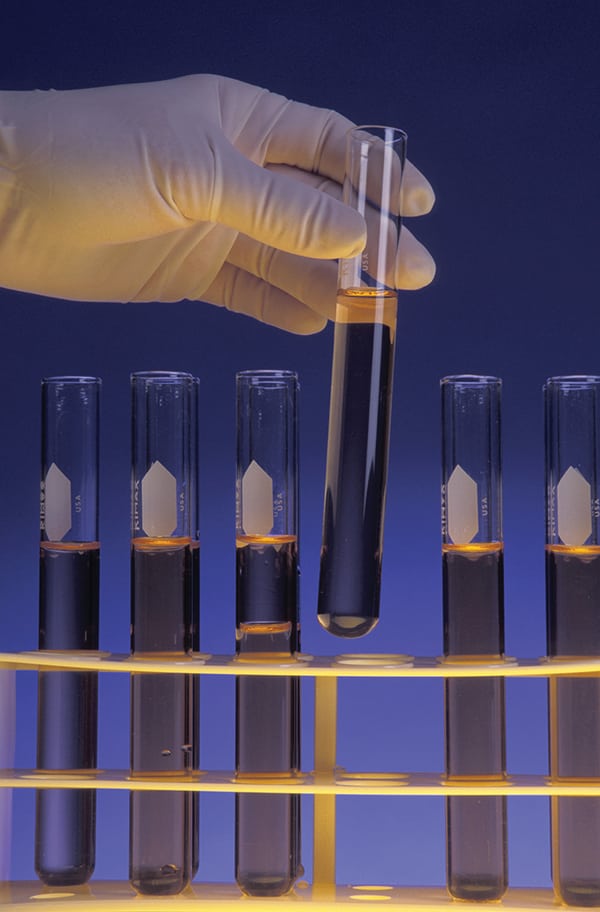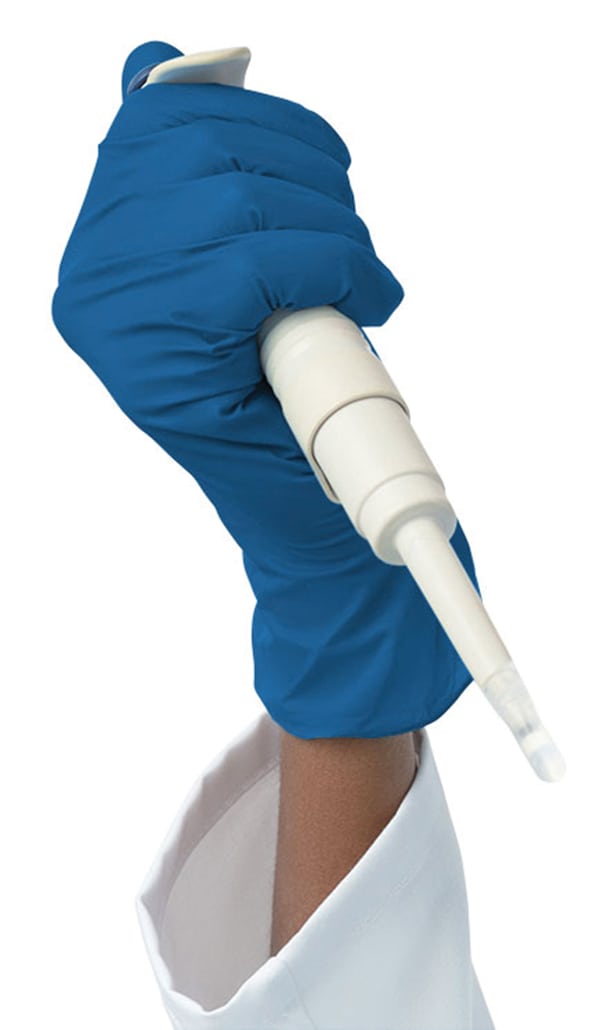When wearing single-use protective gloves, sweat can create health and safety issues. Presented here is a look at the causes of the problems and possible solutions
A great many situations across the chemical process industries (CPI) require quality hand protection, both for worker safety and to prevent product damage or contamination. Examples include working with hygienic processes in the pharmaceutical industry, conducting laboratory research, taking and processing test samples, blending and compounding materials, working with paint materials and others. But regardless of the activity, the natural reaction of human hands to the tight, hot environment inside gloves is sweating. This natural skin response can make wearing gloves uncomfortable and lead to safety risks, as well as lead to skin problems that make the issue worse. Gloves are a necessary precaution, but without taking steps to reduce sweat buildup, gloves quickly become a source of discomfort and health issues (Figure 1). This article presents information about how problems related to sweat in single-use gloves are caused and offers some ideas on how to avoid them.

Figure 1. Single-use gloves protect hands, but also create an occlusive environment that can negatively impact hand health and job performance
Gloves and moisture
The tight, hot environment inside single-use (SU) gloves is a major cause of sweat and irritation for users in every industry. Moisture is one of the most common skin irritants in a glove-protected environment, especially when that moisture stays on the skin for long periods of time. When skin is exposed to sweat for a prolonged time, it weakens and becomes more vulnerable, and the moist environment is the perfect breeding ground for bacteria and fungus. Wetness inside a single-use glove hinders users’ ability to perform certain job functions by limiting dexterity, tactility and mobility. It can also become a safety hazard, since some workers will forego gloves altogether, rather than deal with the sticky, oppressive feeling of a wet glove [1].
Standard single-use gloves provide a non-permeable barrier that protects workers’ hands in light-duty work environments. However, they also create a highly undesirable result — a harsh, occlusive environment between the glove and hand that can negatively impact hand health and, ultimately, job performance. Lack of airflow inside the gloved hand inhibits proper regulation of the skin environment, glove friction from repeatedly rubbing against the skin harms the upper skin layers, and higher temperatures within the glove increase perspiration and discomfort. Additionally, this occlusive environment serves as a breeding ground for bacteria, fungus and other nasty elements that can negatively impact hand health in many ways, especially given that the skin on human hands is much thinner than on other parts of the body.
Imagine wearing a single-use glove in the workplace for hours at a time over a period of days, months and even years. Add in the fact that your hands are “working hard” inside the glove while you grip, move, rub and so on, to complete your work tasks. This leads to friction and mechanical abrasion of the skin further exacerbating an already difficult hand environment. Hand skin layers can become macerated, reducing the skin’s ability to react defensively to external substances, and exposing the skin to even more serious afflictions.
Skin biology
From a physical perspective, where the hand first comes in contact with the occlusive environment, the acid mantle is disrupted and the stratum corneum — the outer most layer of the skin — can become compromised. The outermost section of skin (stratus corneum) has three layers itself. The innermost layer is the actual barrier that regulates absorption into the body. The outermost layer contains cells that, although are not dead cells, have no development process left — they merely serve as the frontline in regulating moisture within the body and keeping unwanted elements out. The middle layer exhibits properties of both the outer and inner sections, a kind of mixing of the two functions.
As the occlusive environment persists, deeper damage begins to take place with the skin structure. Proteins and lipids are stripped away, so skin is unable to keep its natural moisture intact. Barrier protection begins to break down. While sweat contains small amounts of salt and miniscule levels of other waste products, it is predominantly water, and that is what causes most of the damage from prolonged exposure. It can take as little as 72 hours of exposure to water, whether in sweat or elsewhere, to cause significant skin damage [2]. With an occlusive glove environment wrapped around the hands during an eight-hour workday, skin health can be impaired to the point of injury in less than two weeks.
Skin pH is slightly acidic, ranging from 4.0 to 6.5 in a normal environment. Inside an SU glove, your hand loses moisture (sweats) and pH levels quickly rise, further affecting the skin surface and underlying layers. The skin’s ability to regulate its surface diminishes, and the resulting alkaline environment can actually accelerate bacterial growth. The longer the glove remains on your hand, the more damaging this occlusive environment becomes, increasing the likelihood of skin dryness, redness and irritation.
Over time, health risks for workers from uncomfortable SU gloves can greatly decrease productivity, encourage more frequent workplace safety violations and increase the risk of significant medical issues, all of which lead to much higher costs for employers. By limiting hand functionality, perspiration may hinder a worker’s ability to perform certain job functions, or cause them to change gloves more frequently. Yet, repeatedly alternating from a wet to dry environment, like donning and removing several pairs of gloves a day, exacerbates skin irritation. Some workers may forego wearing protection entirely rather than endure the clammy, suffocating feeling of a wet glove, dramatically increasing the risk of safety issues and the potential for worker injuries. According to the U.S. Centers for Disease Control and Prevention, about 70% of workers who experience hand injuries were not wearing gloves at the time [3].
Contact dermatitis
In its normal state, the skin has a low permeability rate, but as barrier function is compromised, that rate begins to increase, exposing the skin to more irritants. The prolonged moisture, increased temperature and unbalanced pH level provide more opportunities for bacteria and other external contaminants to enter the skin, causing further irritation.
Both occlusion and fluctuations in environment with an SU glove can cause a host of skin conditions, such as redness, dryness and chapping. If skin has been repeatedly damaged or these conditions are accelerated by an allergic reaction, bacteria and other unwanted external elements more easily pass through the skin’s compromised barrier. Left untreated, this volatile combination causes increases in skin irritation that can lead to more serious conditions, such as chronic contact dermatitis, one of the most commonly reported occupational diseases. Occupation-related contact dermatitis, classified as either irritant or allergic, can develop from frequent and repeated use of hand-hygiene products, exposure to chemicals and SU glove use.
Irritant contact dermatitis in particular often stems from sweat management issues, and is a very common ailment of SU glove wearers. It is non-allergic, meaning the skin has not reacted with any contaminants or ingredients that served as the irritant. Rather, it stems from the skin coming in frequent contact with a harsh environment that produces dry, itchy, irritated areas around the points of contact, such as repeated hand washing or prolonged exposure to an occlusive environment.
By comparison, allergic contact dermatitis (type IV hypersensitivity) results from exposure to accelerators and other chemicals used in the manufacture of rubber gloves, as well as from exposure to other chemicals found in industrial settings. Allergic contact dermatitis often manifests as a rash beginning hours after contact and, like irritant dermatitis, is usually confined to the areas of contact. Latex allergies are one possible cause of allergic dermatitis, and as a result nitrile gloves have seen a growth in production from glove manufacturers compared to latex equivalents.
Nitrile is a synthetic rubber copolymer of acrylonitrile (ACN) and butadiene, and has been shown to be more resistant to certain oils and acids than natural rubber, while maintaining similar levels of comfort and flexibility to latex. However, some skin issues attributed to latex allergies are misdiagnosed, being rather caused by exposure to accelerators and other chemicals used in the manufacture of both latex and non-latex gloves, such as dithiocarbamates, thiurams, and mercaptobenzothiazoles. These mistaken allergies can be prevented by utilizing gloves that are thoroughly washed after manufacturing, as some glove producers offer to increase user comfort.
While irritant dermatitis is a much more pressing issue when it comes to sweat management, all forms of dermatitis can not only be detrimental to the health of the worker, but also extremely costly to the employer. OSHA (Occupational Health and Safety Administration) calculates that a single case of dermatitis can cost over $11,000 in employer-paid expenses [4].
Glove changes and skin lotions
Common moisture management techniques include frequent glove changes (Figure 2) to limit exposure to prolonged moisture, as well as emollients and creams that provide an additional layer of protection between glove moisture and the skin. Most lotions designed to promote skin healing will serve this end, in particular those containing petrolatum, oat or dimethicone, as they are likely backed by clinical trials [5].
But glove changes impede productivity, since you need to pause work to switch gloves. And as noted above, constantly alternating between environmental extremes can do more harm than good. There are no clear guidelines for how frequently one should switch gloves to prevent skin damage, considering most of the time glove changes are not enough to notably prevent injury if not paired with other solutions.
Likewise, in certain instances, the slippery layer of a cream could negatively impact dexterity and tactile sensation, leading to potential hazards and compromises in safety within the work environment. Skin care products must not undercut the efficacy of antimicrobial soaps and rubs, nor compromise the glove materials used in the working environment. Adding lotions or creams can complicate the overall compliance process, unnecessarily increase donning time and ultimately increase cost per use.
Newer technologies
Sweating while wearing a single-use glove is inevitable, but managing moisture is vital for worker health and productivity. Newer technologies within a glove help manage this interior environment and make the wearing experience much more comfortable and productive, while providing benefits that protect skin from the occlusive environment itself.
One such technology incorporates an absorbent liner that wicks moisture from the skin. SU gloves with an interior moisture-wicking layer help prevent irritation, as well as provide a safer environment for skin to heal if it has experienced any trauma that left the skin surface compromised. This layer is typically a cotton-based powder or dust-like material, and is applied via a spray adhesive on the glove interior. In other words, creating a dryer ecosystem within the glove provides a healthier environment for the hand. By absorbing hand sweat as it is produced, users can prolong the use of one pair of gloves for hours, up to a full work day, without needing to change due to irritation. The structural integrity of the gloves is also extended, as interior moisture can cause latex or nitrile to weaken and eventually break. Additionally, therapeutic properties and protective ingredients manufactured right into a glove can limit the potential for irritation from the occlusive environment on the inside.
A common issue across industries is unreliable glove thickness. Some manufacturing processes produce gloves that vary significantly in thickness in different locations on the glove — during production, gravity can cause still-hardening latex or nitrile to pool at the glove cuff or fingertip, leaving some areas weak and prone to breaking or too thick and lacking in tactility. So some glove manufacturers have responded by employing additional techniques to ensure uniform glove thickness, resulting in gloves that are strong and tactile only where you need them to be.
Choosing the right glove — in terms of thickness, material, size and performance technologies — is essential, as these attributes all contribute to creating the ideal environment to promote proper hand health as well as optimum function. Exact user needs and corresponding glove characteristics, such as puncture or abrasion resistance, are mostly determined by application. Users need to consider whether there is time to change gloves or apply a sticky cream before donning gloves, or whether it is it best to use gloves that will provide a more balanced, safer hand health environment from the start. Workers and employers should also be sure to consider the occlusive environment and its effects before selecting the best gloves for their purposes.
Edited by Scott Jenkins
References
1. LaVerne, G. Jr., When Workers Won’t Wear Gloves, Industrial Safety and Hygiene News, February 2012. Accessed online at www.ishn.com.
2. Willis, I., The effects of prolonged water exposure on human skin, Journal of Investigative Dermatology, Vol. 60 (3), pp. 166–171, 1973.
3. Industrial Safety & Hygiene News, 70% of workers who injure their hands aren’t wearing gloves, www.ishn.com.
4. Occupational Safety and Health Administration, Estimated costs of Occupational Injuries Illnesses and Estimated Impact Worksheet, www.osha.gov/dcsp/smallbusiness/safetypays/esimator.html.
5. Phalen, R., Hand health: Preventing dermatitis when using gloves, www.glovesbyweb.com blog post, Aug. 2014.
Author
 Tom Draskovics is the chief marketing officer at single-use nitrile glove manufacturer SW Safety Solutions Inc. (33278 Central Avenue, Unit 102, Union City, CA 94587; Phone: +1-510-429-8692; Email: [email protected]). Draskovics was formerly president and general manager at Ansell in Iselin, N.J. and led its Specialty Markets Global business unit. In April 2015, Draskovics joined SW Safety Solutions because of their innovative and quality-driven approach to single-use nitrile glove manufacturing. As the chief marketing officer, he helped develop and execute a new business strategy, repositioning the company as both an OEM and branded leader in the single-use glove market, and a new strategic marketing plan that focused on target verticals, technologies and products.
Tom Draskovics is the chief marketing officer at single-use nitrile glove manufacturer SW Safety Solutions Inc. (33278 Central Avenue, Unit 102, Union City, CA 94587; Phone: +1-510-429-8692; Email: [email protected]). Draskovics was formerly president and general manager at Ansell in Iselin, N.J. and led its Specialty Markets Global business unit. In April 2015, Draskovics joined SW Safety Solutions because of their innovative and quality-driven approach to single-use nitrile glove manufacturing. As the chief marketing officer, he helped develop and execute a new business strategy, repositioning the company as both an OEM and branded leader in the single-use glove market, and a new strategic marketing plan that focused on target verticals, technologies and products.
